The Featherbed frame was applauded at the time for its handling. Which is not surprising, since Norton designed it to compete in the Isle of Man TT, before it found its way into production models. But many preferred Triumph’s 650cc, parallel-twin mill to Norton’s vertical twin engines. The Triumph engine vibrated less and was considered stronger and more reliable. It was also easier to tune for more power.
Mounting it to the Featherbed frame required engine conversion plates, so builders could experiment with the engine’s position, which would in turn affect the handling. The Norton’s suspension and brakes were often retained, and in some cases (when pre-unit Triumph engines were used) its gearbox as well.
Most Tritons received Manx-influenced styling: solo race seats, rear sets, clip-ons and sweptback pipes. What started as a shed-built concept soon turned into a mythical marque, and today Tritons are considered some of the most desirable vintage motorcycles on the road. Here are our favorites.
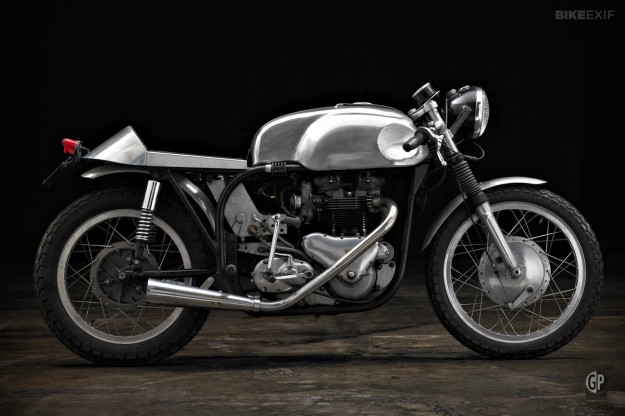 Freddie Cooper In 1960, Motorcycle News
bet English motorcycle racer Freddie Cooper that he couldn’t build a
race bike for £100. Cooper, an experienced builder (and the first man to
top 200mph on English soil), won the bet when he presented one of its
journalists with this Triton to ride at the Isle of Man TT.
Freddie Cooper In 1960, Motorcycle News
bet English motorcycle racer Freddie Cooper that he couldn’t build a
race bike for £100. Cooper, an experienced builder (and the first man to
top 200mph on English soil), won the bet when he presented one of its
journalists with this Triton to ride at the Isle of Man TT.It sports many contemporary parts: a Miller headlight and Lucas tail light, John Tickle triple trees and headlight brackets, Manx clip-ons, and Dunstall megaphones. The cylinder head is a 9-stud T120 item and the rims are 18” Akront alloy. It’s probably the most authentic example of both a Triton and a café racer that you’ll ever come across, and went under the hammer at the 2012 edition of Wheels & Waves. If anyone knows who bought it (and what it cost them), we’d love to know. [More about this bike]
Image by Benoit Guerry.
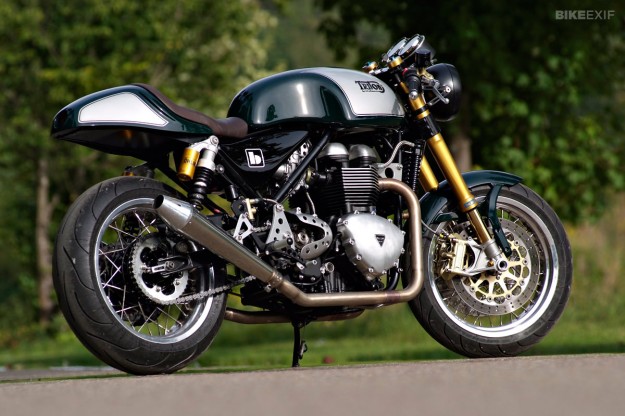 Britalmoto ‘New Triton’ Is it possible to build a
21st-century Triton? This example from Britalmoto is an emphatic ‘yes’.
It has the requisite Norton frame and Triumph engine—but neither are
from the 60′s. The owner had bought a modern Norton Commando 961 but
wasn’t happy with the engine and transmission. “He knew the potential of
the current Triumph twins,” explains Britalmoto’s Ivo Tschumi, “so he
asked us to transform his Norton into a ‘New Triton’.”
Britalmoto ‘New Triton’ Is it possible to build a
21st-century Triton? This example from Britalmoto is an emphatic ‘yes’.
It has the requisite Norton frame and Triumph engine—but neither are
from the 60′s. The owner had bought a modern Norton Commando 961 but
wasn’t happy with the engine and transmission. “He knew the potential of
the current Triumph twins,” explains Britalmoto’s Ivo Tschumi, “so he
asked us to transform his Norton into a ‘New Triton’.”Ivo and his father Fritz fitted a Triumph Thruxton mill, re-engineering the engine mounts and swingarm supports. They then upped the engine’s capacity to 1087cc for a hearty 96hp at the rear wheel and 104Nm of torque. The Norton’s stock Öhlins suspension and front wheel where retained, but the rear wheel was swapped out for the Thruxton’s. Other upgrades include an EBC Racing clutch, QD Exhausts mufflers and Brembo and Nissin brakes front and rear.
The tank comes from the 961, but the tail unit was replaced for a slimmer rear end. As modern takes on classic concepts go, this one’s a winner. [More about this bike | BritalMoto]
Image courtesy of and © Sabine Welte 2013.
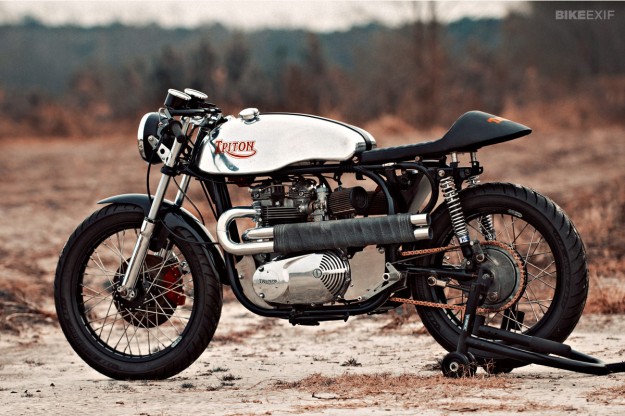 Loaded Gun Customs The story goes like this: Chris
Keaton, owner of the Baltimore Tattoo Museum, wanted a Triton built. So
he contacted Loaded Gun’s Kevin Dunworth via Kevin’s tattoo artist
brother. Chris already had some of the parts needed—including an engine
built by Arno St Denis, a legend in vintage Triumph circles who worked
on the engines of racer Hubert ‘Sonny’ Routt.
Loaded Gun Customs The story goes like this: Chris
Keaton, owner of the Baltimore Tattoo Museum, wanted a Triton built. So
he contacted Loaded Gun’s Kevin Dunworth via Kevin’s tattoo artist
brother. Chris already had some of the parts needed—including an engine
built by Arno St Denis, a legend in vintage Triumph circles who worked
on the engines of racer Hubert ‘Sonny’ Routt.The only problem was, other than the engine and the tank, most of the parts were in a shocking condition. Kevin picked the least bent frame, put it in a jig and set to work—re-aligning the rear stays, dropping the swing arm pivot one inch and changing the head angle to 25 degrees. The engine was mounted using Loaded Gun’s own Triton conversion plates, with Mikuni carbs and flowed intake manifolds. Arno St Denis’ work had included a lightened crank, dynamic balancing, a port job, 10:1 pistons and a modified valve train—Kevin estimates the capacity at around 830cc.
Up front is a set of Atlas triple trees, Commando fork legs and a Commando hub laced to a 19” Sun rim by Buchanan’s. The rear rim is a matching 18” unit on a Triumph conical hub, and the shocks are from Hagon. There are also Brembo brakes from a wrecked Ducati 916 and cro-mo bars from Lossa Engineering.
Chris wanted a raw and unfinished look, so Kevin obliged: “The bike looked old and ridden as soon as we finished it.” [More about this bike | Loaded Gun Customs]
Image by Ken Driscoll.
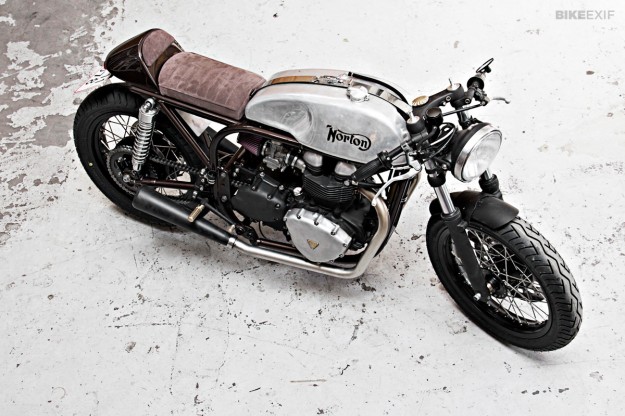 Featherbed 865 Scandinavian mechanic Lars Lykkegaard
struggled to get the troublesome old 650cc Bonneville engine in his
Triton to behave. So, rather than attempt a potentially costly
renovation, he bought a 2010 Triumph Thruxton, ripped out the engine and
popped it into the 1954 Featherbed frame.
Featherbed 865 Scandinavian mechanic Lars Lykkegaard
struggled to get the troublesome old 650cc Bonneville engine in his
Triton to behave. So, rather than attempt a potentially costly
renovation, he bought a 2010 Triumph Thruxton, ripped out the engine and
popped it into the 1954 Featherbed frame.A friend of his then milled a bunch of custom parts for him, including clip-ons, yokes, engine converter plates and brake caliper brackets. Lars himself designed some brass bits: foot pegs, an oil cooler and an ’865′ logo for the engine. He also fitted the Thruxton’s forks (lowered 50mm) and wheels—rebuilding the latter with stainless steel spokes. The exhaust is homemade, also using stainless steel. The new engine’s fuel pump and filter have been concealed in the original 1960s tank, the ECU’s been remapped and the ignition’s been replaced by Motogadget’s keyless M-Lock unit.
All this was done in a small home garage, during a chilly North European winter. [More about this bike]
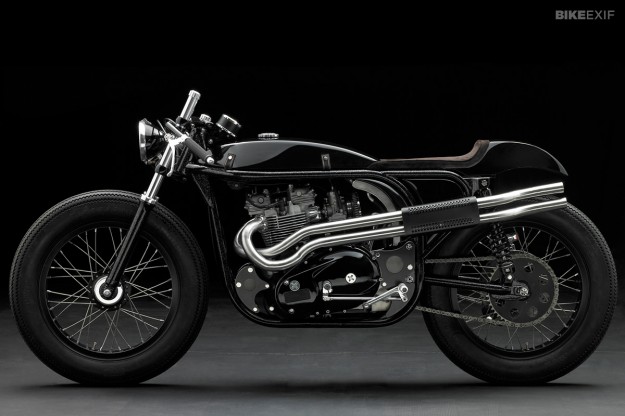 CP Project One This strikingly elegant machine was the
first of the CP Project bikes. It’s also one of the most beautiful
motorcycles ever built. ‘CP’ comes from the initials of designers Frank
Charriaut and Vincent Prat, who were inspired to create a new kind of
Triton after visiting the Legend of the Motorcycle Concours d’Elegance
in California in 2008.
CP Project One This strikingly elegant machine was the
first of the CP Project bikes. It’s also one of the most beautiful
motorcycles ever built. ‘CP’ comes from the initials of designers Frank
Charriaut and Vincent Prat, who were inspired to create a new kind of
Triton after visiting the Legend of the Motorcycle Concours d’Elegance
in California in 2008.Charriaut and Prat decided to set aside the usual norms of British café racers, and started sketching. The result is straight from comic book culture: a motorcycle that would look at home in Batman’s garage, and with the sensuous curves of Catwoman. To help translate the design into reality, violinmaker-cum-bike builder Daniel Delfour joined the project; another French guru, Momo, provided the finishing touch via the exhaust system and deep black paint.
Shortly afterwards, Karl Lagerfeld cast the Triton as the star in a promo film for his 2010 collections: Not surprisingly, it completely upstaged its co-stars, the models Lara Stone and Baptiste Giabiconi. [More about this bike | Southsiders MC]
Image by Guerry & Prat.
The post Top 5 Triton motorcycles appeared first on Bike EXIF.












